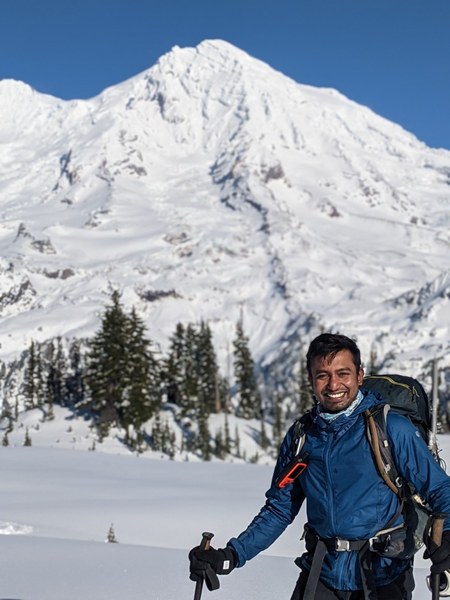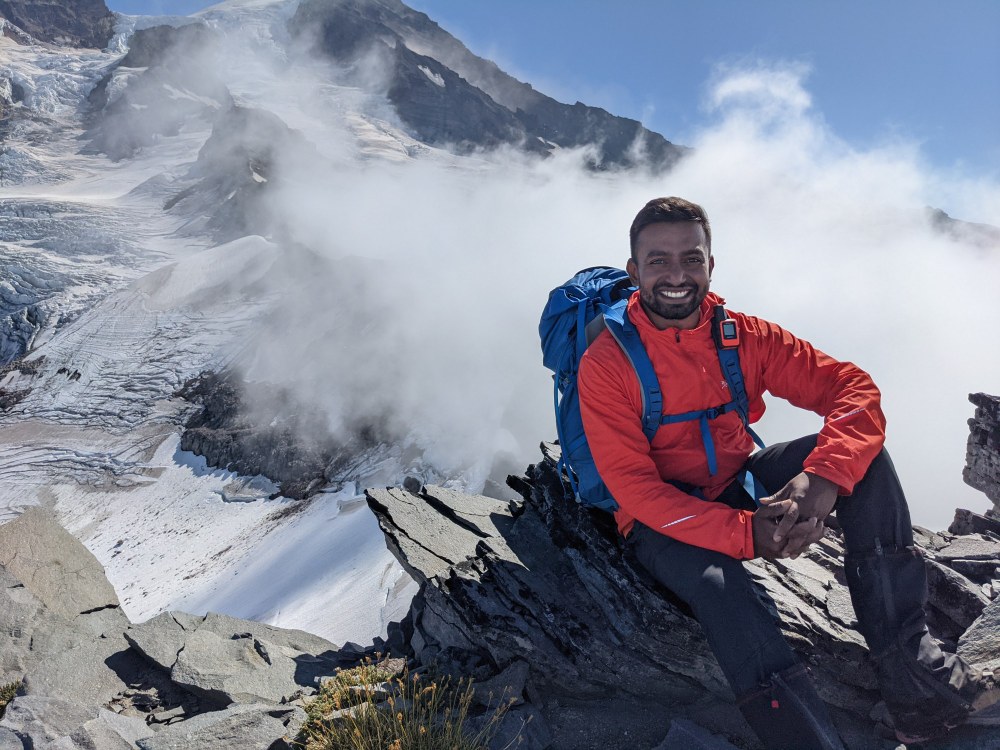
Mount Rainier National Park (MRNP) is one of the oldest national parks in the country, and also one of the most visited. Home to the highest volcanic peak in the contiguous United States and the largest alpine glacial system outside of Alaska, it’s no wonder that people come from near and far to appreciate its beauty.
Most visitors justifiably flock to well-known destinations, but there are dozens of other wonderful places — less well-known and perhaps a bit more difficult to find — that have a beauty all their own. Over 100 peaks (not counting Mount Rainier itself) can be found either within or immediately adjacent to the park boundary. While most are scrambles (and a few are climbs), 15 peaks are hikes. These are collectively known as the Rainier 100 Peaks.
Few people have climbed all 100 Peaks, and Mountaineers Super Volunteer, 2021 Leader of the Year, and 6-year member Ananth Maniam is one of them. If his name sounds familiar, that’s because we featured Ananth in our Summer 2020 magazine for summiting more than 300 peaks, all without a car. He’s also known for always carrying an Ice Mule, which will keep ice cream frozen for 36 hours. Anyone who’s been out with Ananth knows he’s 100% about ice cream, 100% of the time.
For this piece, we talked about his relationship with the outdoors, what inspired his Rainier 100 attempt, some of the more memorable experiences in the park, and why it’s important for all people feel belonging in the outdoors. Below are excerpts from our conversation.
I used to spend a lot of time at my grandparents' farms in Chennai, India, doing farm labor and climbing coconut trees for fun, all while looking at distant mountains. No one in my entire family, or even generations back, has ever climbed a mountain.
Growing up at sea level, and with no experience in mountain life, I booked my first trip to Kashmir to trek across the Great Lakes in the Himalayas. I faced many challenges: language, race, size, age, etc. But I wanted to prove to myself that everything can be overcome. I wanted to do something different.
When I moved to Seattle, I learned about The Mountaineers. I wanted to go out often to learn and explore new places and cultures. I joined in 2016 and started hiking, using public transit to get there. My friends told me the public transportation here is not adequate for trail life. I disagree; there are more challenges here as a non-familiar face in the mountains.
Rainier has been the heart and soul of my climbing experience. When I first started doing trips around Rainier, people used to ask, “Are you lost? What are you doing here?” They’d provide unsolicited advice on how to hike, how to get down, and how it is dangerous to climb. I wanted to put all this to rest. I wanted to break stereotypes by showing ways for more people to enjoy the outdoors. I enjoy bringing diverse crowds into the mountains to share the awesome outdoors of the Pacific Northwest.
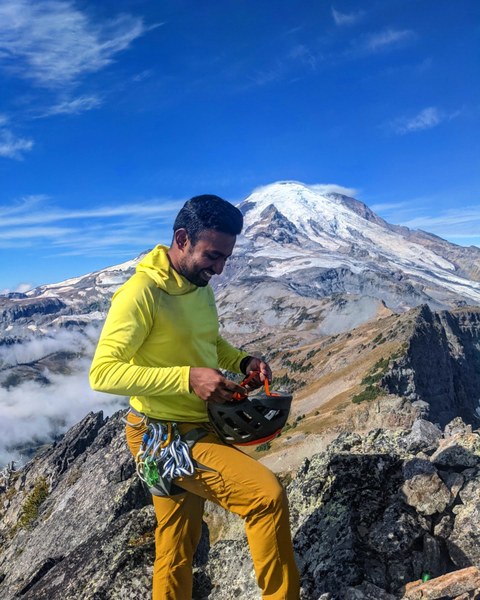 Ananth at the summit of Cowlitz Main Chimney, fall 2021.
Ananth at the summit of Cowlitz Main Chimney, fall 2021.
I took a scrambling course in 2017, and one of my early snow scrambles was to Mount Ruth in MRNP. Mount Ruth is located right below the Emmons Glacier climbing route, which leads to the summit of Mount Rainier itself. This trip was one of the most inspirational and memorable in my mountaineering life. It was a blue bird day when we started from the trailhead. Jim Powell, one of my favorite leaders, led the trip and I’d gotten there by carpooling with another participant. We walked past meadows, glacial streams, and into the open snow slopes. We made the summit and a beautiful glissade followed.
During this trip, I realized that group skills are everything. All of the participants were sharing different information about climbing lists or climbing different peaks in the park. When I got home, I looked up all of the lists to see if any name on the list sounded familiar or like someone who I can relate with. I didn’t see any. So I researched more and began to think, there's no reason why I can’t pursue these climbs and share the information as a way to do my part in making these beautiful parts of Washington accessible to more folks.
The trip to Mount Ruth marked my first of the Rainier 100 Peaks, which would take 5 years to complete. From 2017-2019, I continued to work on the scrambles and climbs, only using carpooling or public transportation, summiting 58 peaks over 4 years. In 2020 I gained access to a car, which was a huge privilege, making it easier to do the final 42 peaks in just 10 months.
One of the more memorable trips was to Little Tahoma in July 2020. It was my second attempt at the biggest mountain after turning around exactly 30 days before. We could not get an overnight permit for either attempt, which meant we had to do a very long day. It involved walking through the beautiful Wonderland Trail with meadows just starting to pop, then going over to the Meany Crest at sunrise and watching the alpine glow over Little Tahoma, all while seeing climbers going up the Emmons route.
During our first attempt, we had to wade through knee-deep fresh snow at some points, breaking trail as we were the only party on the mountain. After a nice break to have some McChicken sandwiches, we trudged into the steep summit section but had to turn around as we saw avalanche releases. While turning around can always be difficult after a long tiring effort, safety and coming back home in one piece is always the priority.
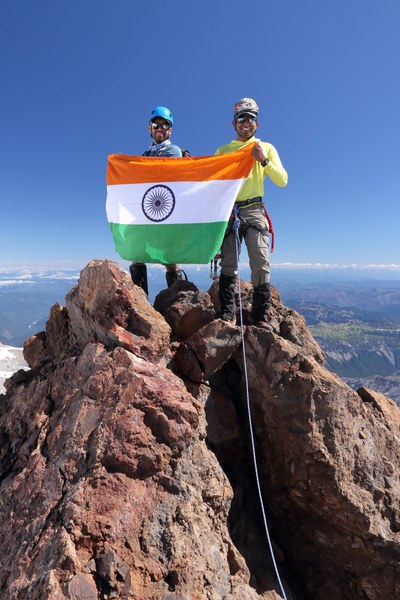 Ananth and Amrit Panda on the summit of Little Tahoma, July 2020.
Ananth and Amrit Panda on the summit of Little Tahoma, July 2020.
We went back again a month later in July 2020, with some of the best people I’ve met in the mountains. Rick Teudt, Sean Mathias, Jacob Lopilato, Amrit Panda, and Ryan Pope. This time we made the summit, even though lots of sections were under snow and the knee-deep snow was packed with ice. Travel was so much different, and easier. The nature of Rainier dictates its own way, and all we have to do is listen.
One of my most beautiful and remote experiences was the Cowlitz Chimney in September 2021. From this trip, I learned that challenges and barriers don’t just come from mountains, but also from people who have a say in how you do things. Being a leader with The Mountaineers has been a great, life-changing experience, and my perspective has evolved after leading more than 100 trips for the club. The first goal of the leader is to bring everyone back safely. As a leader, safety can never be compromised, however summit attempts can be. I have learned to evaluate conditions on the go, always keeping in mind the safety of the group, constantly assessing the skill levels on the field, and involving all participants in group decision making. Decision making is a constant process.
 Cowlitz Main Chimney in the clouds.
Cowlitz Main Chimney in the clouds.
While spring, summer, and fall are the most common times to visit the Rainier 100 peaks, Rainier is one of the most accessible national parks, with 365-day access at some entrances. Snowshoeing and winter scrambling are common activities. One of my favorite winter scrambles was to Mount Ararat, which is most commonly accessed from the Longmire entrance.
Winter mountaineering requires stronger group coordination and careful planning, as the group works through a narrow time window (of daylight or weather) during a day trip. The trails of summer are usually covered in snow, making it a true winter wonderland. Climbers usually make their own route, working through avalanche terrain and dangers. We traveled the snow-covered Wonderland Trail for about 6-7 miles before going off-trail to the summit of Mount Ararat. It was a beautiful blue bird day, where we had not just a beautiful view of Mount Rainier, but all the surrounding peaks. On a winter outing, our groups are often the only ones on the mountain.
There are many challenges to climbing the peaks, and some have nothing to do with being outside. Pursuing a list like the Rainier 100 has additional hidden barriers for a certain minority of the population. While access to mountains can be a challenge, implicit barriers, like race and gender, and explicit barriers, like skills and gear, exist too. People on temporary visas (a work visa in my case) in this country can’t afford to take months off, and sometimes can’t take lots of days off, for the fear of losing their jobs, which would mean getting deported within 60 days. I moved to the US in 2016, and for the initial 2-3 years, my focus was to make sure I did not lose my job and that I performed to my fullest potential, even when it meant working long hours and weekends. I was able to dedicate 10-20% of my life to outdoor adventures and 60-70% of my life was dedicated to work and work-related things. As I established myself and got over my fear of losing my job, I was able to spend a lot more time in the mountains.
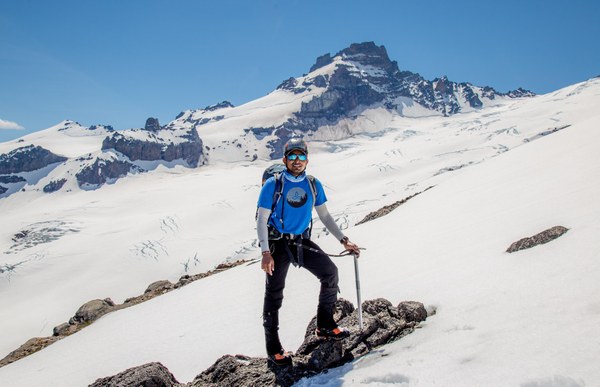 Ananth during his trip to Mount Ruth as a scrambling student, May 2017.
Ananth during his trip to Mount Ruth as a scrambling student, May 2017.
Apart from Susan Shih, no other person of color has climbed all the 100 peaks before (according to the official reports on Peak Bagger). I grew up with the lessons to "Always give what you have to others who don't have," and "Always show things which others can't afford to see." These words inspire me to do something for people like me who would love to explore outside but can't do it on their own. As an immigrant in this country and as someone whose first language is not English, there have been extra difficulties and challenges. Translating some of the trip reports into my native language (Tamil) to get some information is even more cumbersome.
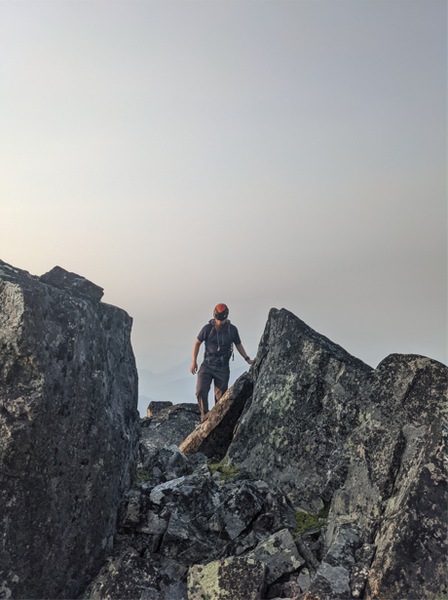 Jon Larson navigating to the summit of Sluiskin the Squaw, August 2021.
Jon Larson navigating to the summit of Sluiskin the Squaw, August 2021.
Sluiskin the Chief, a remote peak from the carbon river entrance, is considered a basic alpine climb. This is a trip that had me spending multiple hours planning for contingencies. We planned to climb Sluiskin the Chief, Sluiskin the Squaw, Redstone Peak, and Pigeon Peak, all as a 2-3 day trip. The Chief is also known for the death of a well-renowned climber, Tim Hagan, after a rappel accident. At the time of his death, Tim was climbing Sluiskin Mountain, a 7,026-foot peak in the Crescent Lake area of Mount Rainier. He was with two other climbers who hiked out 13.5 miles to notify rangers about the fatal accident. Tim was attempting to complete the 100 Peaks at Mount Rainier National Park and Sluiskin was the 99th peak on his list. Tim’s reports and GPX tracks have always been a helpful resource for many of us to navigate to the summit of many of the 100 peaks. Pradnya Mohite and I had planned to do this climb. We discussed contingency plans and finding emergency contacts in case something were to happen to us, as both our families are 8,000+ miles away. We went back and forth on climbing this peak and took the most conservative approach on all of our steps. We made the trip only leaders’ permission required, and two amazing climbers - Jon Larson and Barb Mottler - joined us. We had to bike, hike, camp, scramble, bushwhack, cross an overflowing glacial stream, rock climb, and rappel.
In mountaineering, there are inherent risks that we take. Climbing is a dangerous activity. With the potential of injuries and even death, going outside adds a lot more anxiety for immigrants whose family are outside of the country and can’t reach us in case of an emergency due to border restrictions. Planning for these activities needs not just technical preparation, but mental preparation, along with a strong group of climbing partners. Every single chance on the summit, if there is cell phone reception, I make a call to my family 8,000 miles away to show them the beauties of this state. Even with the extra preparation, there is always a constant fear of “What if?” If something happens to me, will my family get to see me one last time? If I get injured and I need multiple months of rest, will I lose my job and get deported? If something happened, who will be my emergency contact, with my family 8,000 miles away?
Ananth at the summit of Mount Ararat leading a winter scramble, November 2020.
The further I got on the list to climb the 100 peaks of Rainier, the more remote the mountains were and the diversity of folks was reduced. It kind of felt like the most beautiful parts of the park are restricted only to a small few. My biggest goal during this exercise was to have detailed trip reports and stories for people to learn more about the park and access it. As access to Washington's mountains becomes more democratized and hidden barriers are removed, I would really love to see more people of color, more people from economically disadvantaged communities, more immigrants, and more families, pursue hiking or mountaineering.
You can learn more about the Rainier 100 and Ananth Maniam by reading “Secret Rainier” or “10 Essential Questions: Ananth Maniam.” Members can also download the Guide to 100 Peaks at Mount Rainier, written by long-time Mountaineers trip leaders, Gene Yore and Mickey Eisenberg.
This article originally appeared in our Summer 2022 issue of Mountaineer magazine. To view the original article in magazine form and read more stories from our publication, visit our magazine archive.
Lead Image of Ananth on the summit of Tokaloo Rock, fall 2021. All photos courtesy of Ananth Maniam.
Add a comment
Log in to add comments.Thanks for the feature Mountaineers. So Glad to share this story with the rest of the community!
 Kristina Ciari Tursi
Kristina Ciari Tursi
